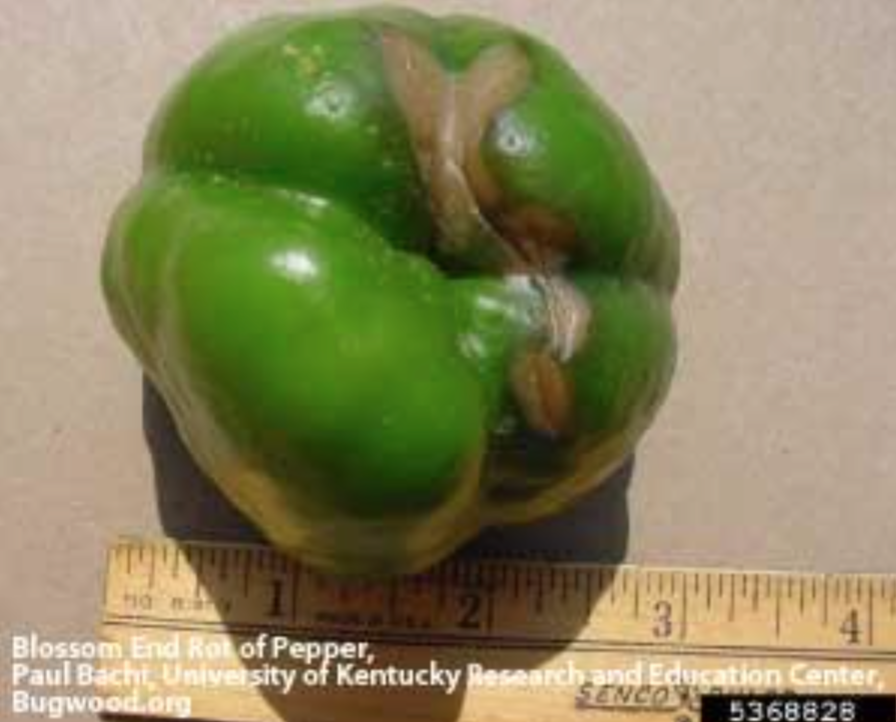Blossom end rot (BER) is a common problem of tomatoes, but is also found on peppers, eggplant, squash and watermelon. It appears as flat, dry, sunken, brown tissue on the blossom end of the fruit, opposite the stem end. The rot is first seen as a small, water-soaked spot on the base of half-developed fruits and continues to enlarge as the fruit matures. The size of the rotted area varies, but can cover 30 to 50% of the fruit.
On peppers, the affected area is tan and is often confused with sunscald, which causes a white lesion. Affected areas are often colonized by secondary fungi, which affect the remaining fruit making it unuseable. This problem is not an insect or disease problem, but is a physiological disorder associated with a calcium deficiency in the developing fruit.
How does Calcium effect fruit development?
Calcium (Ca) is an important component for normal cell wall development; when inadequate levels of calcium are available to the rapidly developing distal tissues of the tomato, the result is cell breakdown. This condition is rarely the result of a lack of calcium in the soil, but rather occurs when plants cannot pull up calcium quickly enough for the developing tissues.
Calcium is a nutrient with limited mobility in plants; it must be dissolved in water to move within a plant, so water deficits are a frequent contributing factor. The distal, or blossom end, tissues of the tomato fruit also contain fewer vascular bundles, which move water and nutrients from one part of the plant to another, so are most susceptible to a lack of calcium.
Is Calcium deficient in your soil?
If a pre-plant soil test of Calcium levels shows medium (801 to 1,200 lbs Ca/acre) or high levels (greater than 1,200 lbs. Ca/acre), and soil pH measures 6.0 or higher, then existing soil Calcium is sufficient for good plant growth and additional Calcium added to the soil will not correct the problem.
How do environmental factors contribute to BER?
BER can be increased by multiple factors that occur during the growing season. Drought stress, low daytime humidity, and high temperatures favor BER development. Drought stress and low daytime humidity cause plants to lose large amounts of water through transpiration, resulting in more water being sent to the leaves and less to the developing fruits. High temperatures contribute by causing faster fruit enlargement resulting in a greater demand for calcium. Low soil moisture early in the season results in slowed plant and increased blossom-end rot due to the lack of Calcium movement in transpirational water.
Nitrogen (N) and potassium (K) fertilization also effects BER development. Research has shown that excessive shoot growth resulting from overfertilization of N and K during early bloom and fruiting is a major contributor to BER
development. In this situation, Ca again ends up in the new shoots, instead of in the fruits, because the shoots are the area of greatest demand for transpirational water due to the vigorous growth stimulated by N and K fertilization. At the early bloom stage, bell pepper and tomato leaf tissue analysis should show N and K levels both within the range of 4.0 to 6.0 percent. Higher levels may indicate excess fertilizer.
Management of BER
Cultural techniques that can be used to reduce the incidence of blossom end rot include the following:
-
Prevent drought stress on plants by providing at least 1 inch of water per week. Greater amounts will be needed for plants in sandy soils or during very hot, dry conditions. The critical period for water management to avoid BER starts at blooming through fruit development to about golf ball sized fruits. Keep soil moist enough to form a ball when squeezed in your hand that will not break apart.
-
Use an organic mulch like wood chips, clean straw, pine straw, peat moss, compost, herbicide-free grass clippings to preserve soil moisture
-
Reduce fertilization if excessive top growth occurs. Commercial growers could consider switching their Nitrogen fertilizer used from ammoniacal nitrogen to calcium nitrate (CaNO3).
Foliar applications of calcium have little effect on this condition, due to the poor absorption and movement of calcium from the leaves to the fruits. Use of products claiming to stop BER by application of foliar Calcium are not recommended.



